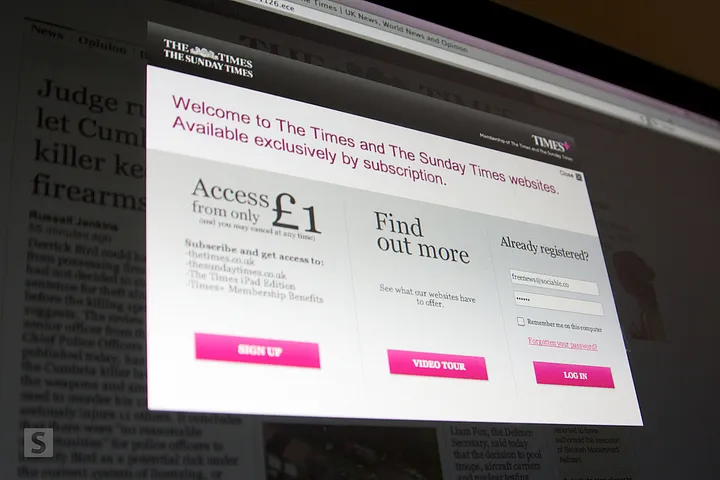Over the years, several publishers have tried their hand at implementing a paywall. These efforts have been met with varying degrees of success:
The Sun introduced a paywall on the 1st of August 2013, partially removed it in the summer of 2015 and removed it completely on the 30th November 2015. The Financial Times introduced its paywall in 2007, however, they chose to relax the paywall in 2015 to combat sluggish growth and The Times introduced its paywall in 2010, which recent news suggests it be performing well.
 Image via The Sociable / Flickr
Image via The Sociable / Flickr
How does a paywall work?
A couple of years ago, I found myself responsible for implementing and maintaining a paywall (disclaimer: not the one pictured above). For the most part, this paywall was successful. The most important lesson I learned from the experience was that there is no one perfect solution, and success is largely about making peace with a necessary compromise.
There are three potential paths to choose from when providing access to your content:
- Allow your audience to read your content for free
- Allow your audience to read a limited amount of content before you ask them to log in
- Force your audience to log in before they can read anything in full
Some pros and cons for each path are:
Allow your audience to read your content for free
Pros:
- A higher number of page views
- A higher number of shares
- Search engines such as Google can evaluate the entire article and work out the relevance
Cons:
Allow your audience to read a limited amount of content before you ask them to log in.
Pros:
- Search engines like Google can still evaluate the entire article and determine relevance, as Googlebot will be included in the “First Click Free” strategy.
- Page views will remain high, as visitors who consume just a single page can still read the content.
- Loyal customers can be converted into paying subscribers.
Cons:
- The number of shares may fall as people generally don’t like to share content that other people potentially cannot see.
- With a little time and effort, users can circumvent limited access restrictions. These restrictions can be cookie-based, IP-based, referrer-based, or registration-based, but all are potentially exploitable.
Force your audience to log in before they can do anything in full
Pros:
- Content is always protected behind a paywall
- A loyal customer base can be converted into paying subscribers
Cons:
- The number of shares and social reach will be lower
- Will alienate a potentially large portion of your audience that will never be interested in subscribing
- Search engines such as Google cannot index content behind a paywall, so you will need to implement a strategy like “First Click Free” to compete with other publishers. This is a “limited access” strategy and is vulnerable to circumvention.
- Uptake might be slow if there is no ‘try-before-you-buy’. How many of us would even part with our email address if we couldn’t view a single article first?
None of these options is perfect, and some compromise is necessary to implement a successful paywall. Your content will determine what compromise you will need to make.
Will a paywall work for me?
To convince anyone to part with their hard-earned cash, you need to provide something of value. If you simply plan to put breaking news behind a paywall and charge for it, you might as well pack your bags and go home now. There are simply too many free sources of breaking news. Use free breaking news to attract your initial audience, and then convert them into subscribers using the content and features that are unique to you.
For example, the editorial paywall I implemented evolved from a smaller paywall which only protected the crossword section of the website. This publication enjoyed a loyal audience which had attempted the newspaper’s daily crossword for years and liked to compare their results with friends, family and colleagues. The online crossword was valuable to these loyal users, as they could enjoy their newspaper’s daily crossword even if they were on holiday, living abroad or simply hadn’t bought that day’s print version.
The decision to implement a paywall will inevitably alienate some of your audience. However, this segment of your audience will probably never be inclined to pay for a subscription, regardless of price. This segment is also more likely to use adblockers, so you will never make a penny from them anyway. Provided the value of your content justifies the costs, you can be confident a portion of your loyal audience will transition to your subscription model.
One last thing
If you do decide to implement a paywall, make sure your subscription fee will cover the removal of advertisements (at least 3rd party ads) for that user. There is nothing worse than paying for access and still getting inundated with advertisements.
Originally published at https://chrisshennan.com/blog/behind-the-paywall-an-insider-point-of-view